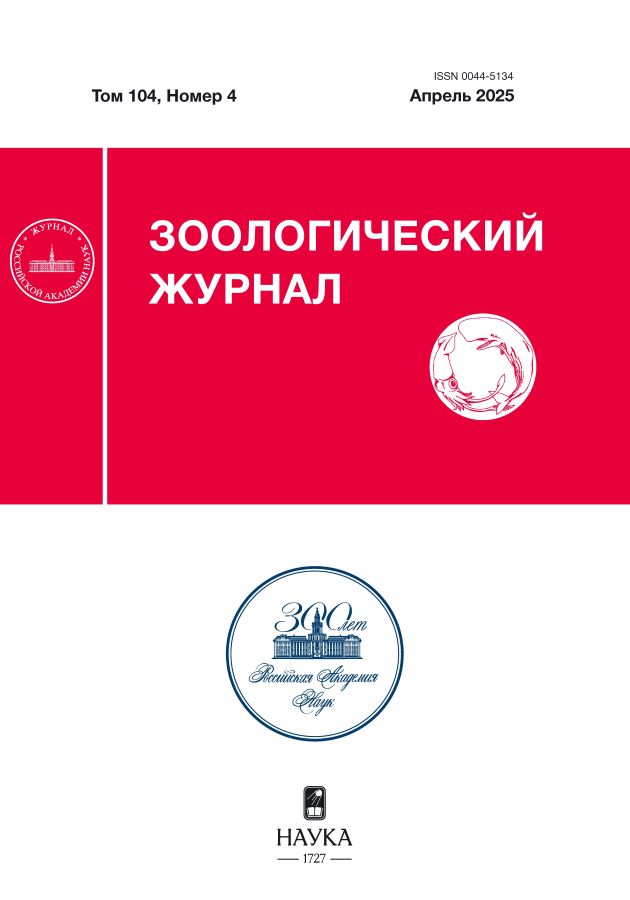Relationship between the Sable (Martes zibellina) and the Musk deer (Moschus moschiferus) in Yakutia
- Authors: Argunov A.V.1, Safronov V.M.1
-
Affiliations:
- Institute for Biological Problems of the Cryolithozone, Siberian Branch, Russian Academy of Sciences
- Issue: Vol 104, No 4 (2025)
- Pages: 97-103
- Section: ARTICLES
- URL: https://rjmseer.com/0044-5134/article/view/684208
- DOI: https://doi.org/10.31857/S0044513425040082
- EDN: https://elibrary.ru/aqonsr
- ID: 684208
Cite item
Abstract
Occurrence of musk deers with traces of sable bites on the auricles in commercial samples from different ecological and geographical regions of Yakutia is noted. In general, among 24 musk deer heads examined, the proportion of individuals with ears injured by sable amounted to 37.5%. The proportion was lower in central Yakutia (14.3%), where sable is fewer, vs higher in southern and northeastern Yakutia (47.0%), where sable is numerous. Until the early 1980s. there were no signs of sable attacks on musk deer in Yakutia. Later, with an increase in the number of sable, climate warming and an increase in the height of the snow cover, the pressure of this predator on musk deer rose. In 1990–2021, 31 musk deer crushed by sable were registered on field survey routes. A large proportion of wounded musk deers in fishing samples indicates regular, although not always successful, sable attacks on musk deer in recent years. Along with climate warming and the snow cover growing thicker, sable predation has increased and become one of the reasons for musk deer migration from the deep-snow montane taiga regions to central Yakutia, the latter being relatively snow-poor and populated by fewer predators.
Keywords
Full Text
About the authors
A. V. Argunov
Institute for Biological Problems of the Cryolithozone, Siberian Branch, Russian Academy of Sciences
Author for correspondence.
Email: argal2@yandex.ru
Russian Federation, Yakutsk, 677007
V. M. Safronov
Institute for Biological Problems of the Cryolithozone, Siberian Branch, Russian Academy of Sciences
Email: vmsafronov28@gmail.com
Russian Federation, Yakutsk, 677007
References
- Аргунов А.В., Сафронов В.М., 2022. Новые данные по распространению кабарги (Moschus moschiferus) в Якутии // Известия РАН. Серия Биологическая. № 5. С. 549–554.
- Аргунов А.В., Тирский Д.И., 2022. Случаи охоты соболя (Martes zibellina, Carnivora, Mustelidae) на кабаргу (Moschus moschiferus, Cetartiodactyla, Moschidae) в Якутии. Зоологический журнал. Т. 101. № 6. С. 703–708.
- Бакеев Н.Н., Монахов Г.И., Синицын А.А., 2003. Соболь. Вятка: ГНУ ВНИИОЗ. 336 с.
- Вайсман А.Л., Фоменко П.В., 2004. Кабарга в России. Охрана, добыча и коммерческое использование // Без лицензии на убийство: состояние популяций и промысел кабарги, торговля кабарожьей “струей” в России и Монголии. М. С. 18–61.
- Вашукевич Ю.Е., Вашукевич Е.В., Козлов Н.Ю., Пересыпкин С.В., 2023. Результаты анкетирования охотников и специалистов охотничьего хозяйства Иркутской области по отдельным параметрам состояния и использования популяций кабарги в Прибайкалье // Вестник охотоведения. Т. 20. № 1. С. 35–40.
- Дулькейт Г.Д., 1957. Вопросы экологии и количественного учета соболя. М. 99 с.
- Егоров О.В., 1965. Дикие копытные Якутии. М.: Наука. 259 с.
- Зайцев В.А., 2006. Кабарга: экология, динамика численности, перспективы сохранения. М.: Изд-во Центра охраны дикой природы. 120 с.
- Зырянов А.Н., 2009. Соболь Средней Сибири: экология, промысел, охрана. Красноярск: Сибирские промыслы. 256 с.
- Зырянов А.Н., Кожечкин В.В., 1991. Случаи нападения соболя на кабаргу // Вопросы охотоведения Сибири. Красноярск: Изд-во Красноярск. ун-та. С. 68–74.
- Кожечкин В., Каспарсон А., 2013. Поведение копытных и хищников в условиях многоснежной зимы // Охота и охотничье хозяйство. № 4. С. 14–16.
- Кожечкин В., Шишикин А., Кельбешеков Б., 2022. Гибель кабарги от хищников в северо-западной части Восточного Саяна // Охота и охотничье хозяйство. № 7. С. 2–13.
- Лавов М.А., 1975. Распространение и примерная численность копытных зверей в Красноярском крае // Вопросы экологии. Труды государственного заповедника “Столбы”. Красноярск. Вып. 10. С. 339–347.
- Лукашев Н.А., Татаринов В.Н., 1974. Питание соболя Западного Саяна в годы с различными уровнями кормов // Сб. науч-техн. инф. ВНИИОЗ. Киров. Вып. 44–45. С. 35–40.
- Маслов М.В., Литвинов М.Н., Литвинова Е.А., Маркова Т.О., 2023. Возможные причины снижения численности кабарги Moschus moschiferus L. (Cetartiodacyla, Moschidae) в Уссурийском заповеднике // Сибирский экологический журнал. № 6. С. 832–838.
- Москов В., 1973. Соболь и кабарга // Охота и охотничье хозяйство. № 4. С. 18–19.
- Олейников А.Ю., Зайцев В.А., 2014. Охота соболя (Martes zibellina) на кабаргу (Moschus moschiferus) // Бюллетень Московского общества испытателей природы. Отд. биол. Т. 119. Вып. 6. С. 20–28.
- Приходько В.И., 2018. Динамика численности кабарги (Moschus moschiferus L.) в России // Вестник охотоведения. Т. 15. № 1. С. 26–32.
- Приходько В.И., 2021. Кабарга: ресурсы, сохранение вида в России. М.: Товарищество научных изданий КМК. 203 с.
- Ревин Ю.В., 1989. Млекопитающие Южной Якутии. Новосибирск: Наука. 320 с.
- Сафронов В.М., 2002. Эколого-физиологические особенности куньих в зимних условиях Якутии // Наземные позвоночные Якутии: экология, распространение, численность. Якутск: ЯФ Изд-ва СО РАН. С. 50–67.
- Смирнов М., Туманов И., Кожечкин В., 2003. Кабарга и ее враги // Охота и охотничье хозяйство. № 9. С. 2–4.
- Степаненко В., 2021. Кабарга и промысловая охота // Охота и охотничье хозяйство. № 6. С. 4–7.












